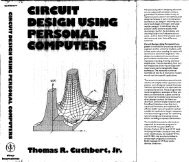Timekeeping in the Electronic Century
Timekeeping in the Electronic Century
Timekeeping in the Electronic Century
You also want an ePaper? Increase the reach of your titles
YUMPU automatically turns print PDFs into web optimized ePapers that Google loves.
But <strong>the</strong>se were analog watches, with dial and hands to show <strong>the</strong> time. 7<br />
Hamilton<br />
hoped that <strong>the</strong> Pulsar's unique appearance would grab consumer attention. Their gamble<br />
paid off. The Pulsar was sensation.<br />
The idea for develop<strong>in</strong>g a solid-state digital watch came not from Hamilton<br />
management, but from two electrical eng<strong>in</strong>eers from <strong>the</strong> company's Military Products<br />
Division, John Bergey and Richard Walton. Their <strong>in</strong>spiration for <strong>the</strong> digital watch came<br />
from both science and science fiction. Bergey remembers that <strong>the</strong> idea came to him <strong>in</strong> <strong>the</strong><br />
late 1960s when Stanley Kubrick hired Hamilton’s Military Products Division to design a<br />
futuristic clock as a prop for <strong>the</strong> movie 2001. At about <strong>the</strong> same time Richard Walton<br />
attended a conference, <strong>the</strong> Timers for Ordnance Symposium, where he heard a<br />
presentation by RCA eng<strong>in</strong>eers about <strong>the</strong>ir research on C-MOS <strong>in</strong>tegrated circuits.<br />
Walton realized that <strong>the</strong>se low-power circuits developed for military purposes could be<br />
used to make an electronic watch, and he returned to Lancaster to write up a proposal. 8<br />
In <strong>the</strong> midst of development work a small Texas Instruments sp<strong>in</strong>-off company,<br />
Electro-Data, approached Hamilton with <strong>the</strong>ir idea for a digital watch. George Thiess and<br />
Willy Crabtree had been develop<strong>in</strong>g a solid-state watch with an LED display, and <strong>the</strong>y<br />
were look<strong>in</strong>g for an established watch company to market <strong>the</strong>ir product. Bergey, by <strong>the</strong>n<br />
director of <strong>the</strong> Watch Division, arranged a contract for <strong>the</strong> Texas company to produce six<br />
prototypes.<br />
On May 6, 1970, a press conference <strong>in</strong> New York announced <strong>the</strong> Pulsar to <strong>the</strong><br />
world. Bergey even took a Pulsar onto Johnny Carson’s Tonight Show. The watches<br />
unveiled <strong>in</strong> New York were noth<strong>in</strong>g but cranky prototypes that failed to work most of <strong>the</strong><br />
time. Develop<strong>in</strong>g a viable watch began right after <strong>the</strong> press conference. 9<br />
____________________<br />
Bletchley talk June 2004<br />
page 6

















